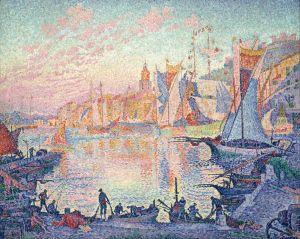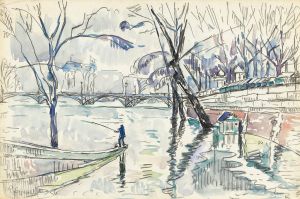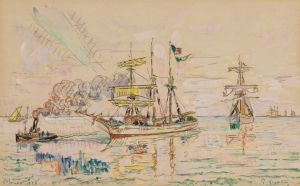
Les Sables d’ Olonne
A hand-painted replica of Paul Signac’s masterpiece Les Sables d’ Olonne, meticulously crafted by professional artists to capture the true essence of the original. Each piece is created with museum-quality canvas and rare mineral pigments, carefully painted by experienced artists with delicate brushstrokes and rich, layered colors to perfectly recreate the texture of the original artwork. Unlike machine-printed reproductions, this hand-painted version brings the painting to life, infused with the artist’s emotions and skill in every stroke. Whether for personal collection or home decoration, it instantly elevates the artistic atmosphere of any space.
"Les Sables d’Olonne" is a painting by the French Neo-Impressionist artist Paul Signac, created in 1890. Signac was a prominent figure in the development of the Pointillist technique, which involves applying small, distinct dots of color in patterns to form an image. This method was pioneered by Georges Seurat, with whom Signac closely collaborated and shared artistic ideas.
The painting depicts the coastal town of Les Sables-d'Olonne, located on the western coast of France. This town is known for its picturesque harbor and vibrant maritime activity, which Signac captures with his characteristic use of color and light. The scene is rendered in a harmonious palette, with the use of complementary colors to create a sense of depth and luminosity. The meticulous application of paint in small dots allows the colors to blend optically, giving the painting a shimmering quality that evokes the sunlight reflecting off the water.
Signac's interest in maritime subjects is evident in many of his works, and "Les Sables d’Olonne" is no exception. The painting showcases his fascination with the sea and the life of coastal towns. The composition is carefully balanced, with the harbor and boats occupying the foreground, while the town's architecture and the sky form the backdrop. This arrangement draws the viewer's eye across the canvas, inviting them to explore the details of the scene.
Paul Signac was deeply influenced by the scientific theories of color and perception that were being developed during his time. He believed that art could be approached with the same rigor as science, and this belief is reflected in his precise and methodical painting technique. "Les Sables d’Olonne" exemplifies this approach, demonstrating how the careful placement of individual dots of color can create a cohesive and vibrant image.
The painting is also a testament to Signac's commitment to the ideals of Neo-Impressionism, a movement that sought to bring a new level of clarity and structure to Impressionist art. By using the Pointillist technique, Signac and his contemporaries aimed to achieve a greater intensity of color and light than was possible with traditional brushstrokes. This method also allowed them to explore the interplay of colors in a more systematic way, leading to a deeper understanding of visual perception.
"Les Sables d’Olonne" is held in high regard as a significant work within Signac's oeuvre. It not only showcases his technical skill and innovative approach to painting but also captures the serene beauty of the French coastline. The painting remains an important example of Neo-Impressionist art and continues to be studied and admired for its contribution to the development of modern painting techniques.
In summary, "Les Sables d’Olonne" by Paul Signac is a masterful example of Neo-Impressionist art, highlighting the artist's use of the Pointillist technique to depict a vibrant coastal scene. Through his meticulous application of color and light, Signac creates a dynamic and luminous image that reflects his scientific approach to art and his deep appreciation for the beauty of the natural world.


















